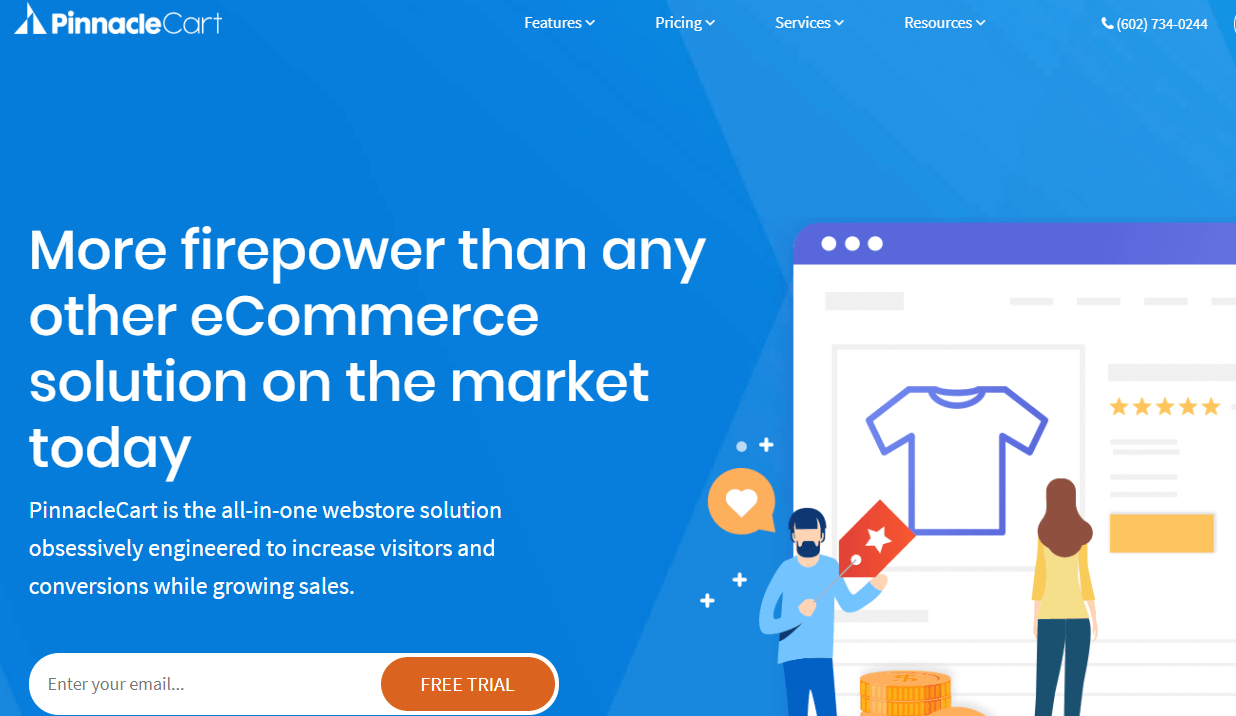Considering purchasing shopping cart solution? This post may be able to help you with making the right decision!
Below, you will find everything you need to know about the best shopping cart software and what they can do for you.
On top of that, to help you get started, we’ll give you an overview of 20 shopping cart solutions that are likely to work for you!
The following order does not mean that the number 1 listed is the best. However, it all depends on your needs and financial budget.
The reviews rank based on price, reliability, support, benefits, scalability, extra options, and more.
Disclaimer.
Please take note that a few of the links below are affiliate links, and at no additional cost to you, we will get a commission if you buy through these links. Thanks for your continued support.
What’s An Online Shopping Cart?
At its very basics, an online shopping cart is the digital alternative of a real, physical shopping cart people use at stores – they likewise allow buyers to gather goods for purchasing.
However, an online shopping cart is actually much, much more functional and performs some unique purposes as well – both for buyers and sellers.
In fact, there is so much to talk about that we’ll later cover the benefits and uses of a shopping cart for each party more in-depth.
Here are my picks for the 20 worthy shopping cart options to consider.
Best Shopping Cart Software
1. SamCart
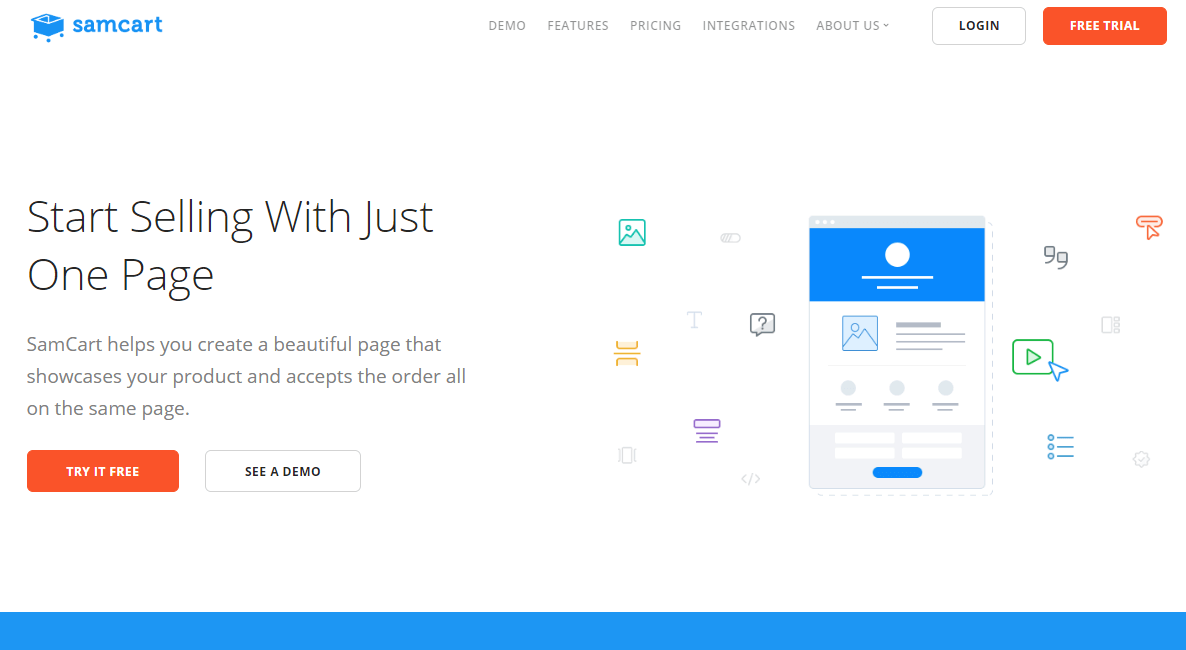
Pricing
SamCart offers 4 plans:
For the first 3 plans, SamCart provides a 14-day trial. The trial requires credit card information, which may repel some potential buyers.
Features & functionality
SamCart is among the most functional cart solutions you can find. It isn’t the best for absolute newbies, but for more or less experienced businesses, SamCart is an excellent option.
Each plan also gets a drag & drop template builder, allowing you to highly customize your customer’s experience.
SamCart has all the basics for successful sales too – it has coupon & discount functionality in all plans, and once you go to the pricier plans, you get upsells, multiple payment options, and advanced reporting.
Starting with the Scale plan, you are getting cart abandonment tracking, A/B testing, and even affiliate management tools!
In terms of integrations, SamCart also is pretty nice – it works with email autoresponder software such as
One thing to note here – the starting Launch plan is noticeably less functional than higher-tier plans.
It lacks many important features such as reporting tools, subscription upsells, multiple payment options, and some other things.
It’s pretty limited, and we don’t think that it’s a good plan to go for (unless it has exactly what you need).
Pros:
- Unlimited pages, products, and templates for all plans.
- Affiliate management functionality starting from the Scale plan.
- 99.98% uptime.
Cons:
- Pretty pricey.
- The Launch plan has limited functionality.
- Only natively supports PayPal & Stripe.
2. ThriveCart
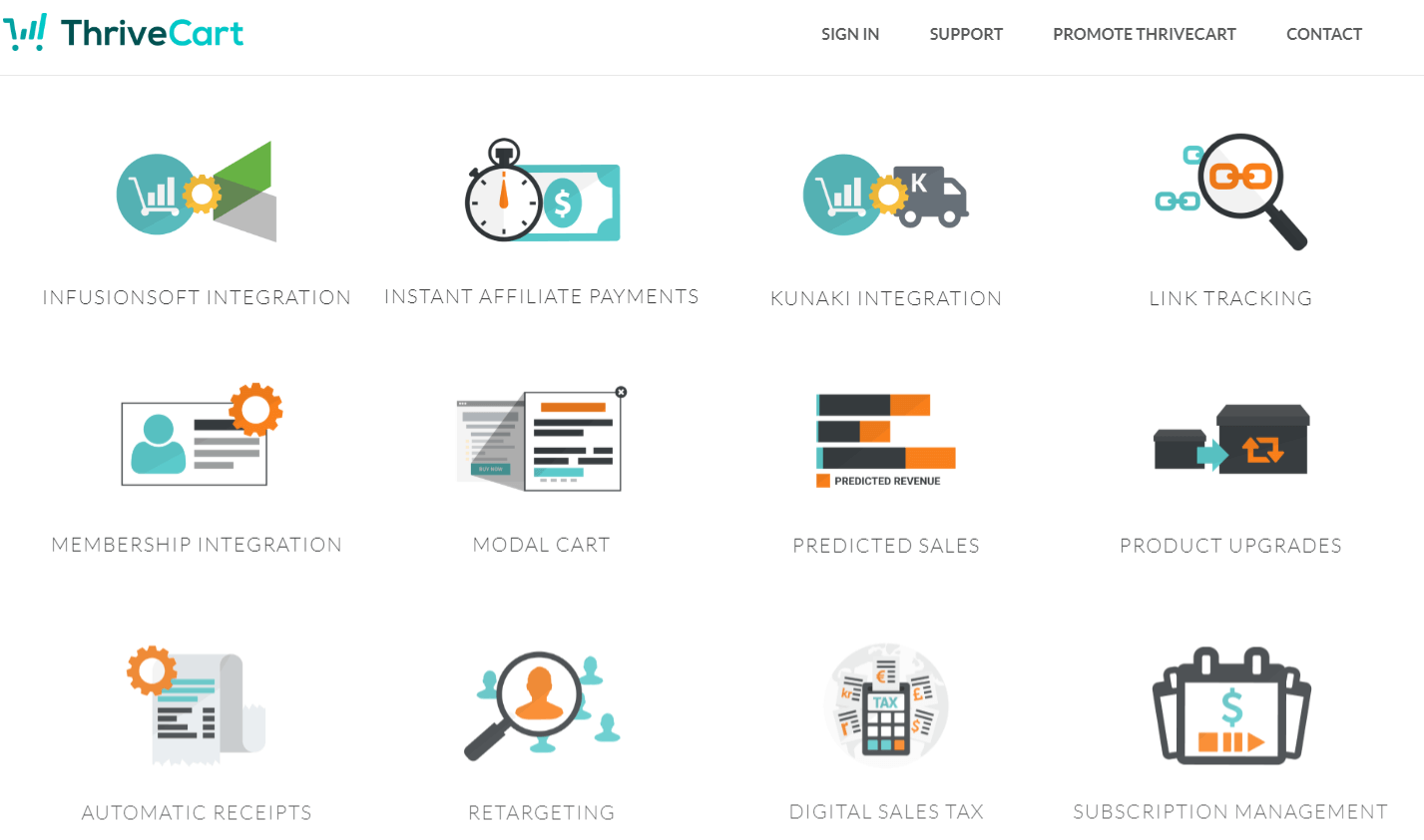
Pricing
As of this review’s writing, ThriveCart was available for life for a one-time payment of $495. This is a limited time offer – ThriveCart wasn’t live when we were writing this post.
ThriveCart was just attracting as many people as they could before launch – once the offer expires, it seems that the pricing will go up to at least $95 per month or $1,950 annually. ( More read here )
Features & functionality
ThriveCart isn’t out yet, but it already looks like a very serious competitor to the big players like SamCart. However, ThriveCart is quite different.
Although marketed as cart software, ThriveCart is more than that – it also allows you to manage affiliates, build sales funnels, and do a few other things.
But more importantly, ThriveCart provides some of the most impressive feature sets we’ve ever seen, including:
This is just touching the surface of ThriveCart’s functionality, but as you can see, this piece of software should be able to satisfy the needs of pretty much any business.
The integrations of ThriveCart are also impressive, including multiple payment gateways (Apple Pay, PayPal, Stripe, Google Pay) and sales funnel platforms (ClickFunnels or 10minutefunnels).
We could go on and on – all in all, we think that ThriveCart is an excellent choice for experienced entrepreneurs or established businesses.
If you think its functionality is just right for you, then $495 might be a good price to pay.
Pros:
- Integrated affiliate management center, funnel builder, and more.
- All-in-one ecommerce solution – not limited to just shopping carts.
- Available for life for $495 (limited offer).
- A wide range of native integrations.
- 99% uptime.
Cons:
Not live as of this post’s writing.Will get pretty expensive once the lifetime access offer expires.No free trials – only a 30-day money-back guarantee.
3. shift4shop (Before 3dcart)

Pricing
Shift4shop offers 4 plans:
The End-to-End eCommerce plan is unique, as it's a completely free plan that includes all the features of the Pro Store plan as well as some extras, but at no cost.
Access to this plan requires merchants to use Shift4 Payments as their payment gateway. It's only available in the US, but Shift4 plans to expand to more countries.
There is also the custom Enterprise plan. Its pricing is calculated on a case-by-case basis, but this plan is also available free for merchants using Shift4 Payments.
All in all, Shift4Shop starts very inexpensively, even if you can't use the free plan.
Since their Pro Store plan costs less than similar plans from their direct competitors, they allow for higher budgeting flexibility for buyers. And if you use Shift4 Payments, Shift4Shop's free plan is a game-changer.
Features & functionality
Shift4Shop is a very functional shopping cart for the money, with more features than any other hosted cart software – it’s not as feature-rich as ThriveCart (particularly, it has no free trial management tools).
But if you just want to sell products and services (whether physical or digital), Shift4Shop is more than enough.
What’s very nice about Shift4Shop is that the features of all the plans are largely similar, so you aren’t missing out on much by opting for cheap plans (though some things are missing in it, like FedEx returns, delivery estimate previews, pre-orders, product Q & A, or recurring orders).
The free plan includes everything and also removes limits on staff users, and gives free access to all Shift4Shop apps in their App Store.
But all in all, Shift4Shop’s cheap plans don’t feel as limited as with most other shopping cart solutions– all plans support inventory control, bulk discounts, multiple shipping address checkout, reports, tax rates, reviews, upsells & cross-sells, cart saving, coupons & discounts, and other things.
As an eCommerce solution, Shift4Shop also offers affiliate management, blogging tools, and newsletters.
As an ecommerce solution, Shift4shop also offers affiliate management, blogging tools, and newsletters.
Pros:
- Free Pro-level Plan ($229+/per month value)
- As an eCommerce solution, more functional than the typical shopping cart.
- The features are largely similar across all plans.
- A whopping 4 plans to choose from.
- Plenty of payment options (including Visa, Google Pay, and Apple Pay.)
Cons:
- No free trials – only a 30-day money-back guarantee.
- Free plan available to US merchants only.
4. Ecwid

Pricing
Ecwid offers 4 pricing plans:
Ecwid has no free trials, but the Free plan is, well, free. It’s not a full replacement since it has limited features, but it still gives some insight into what Ecwid can do.
All in all, Ecwid is rather cheap, but its feature set is only fully uncovered at the Business and Unlimited plans.
They aren’t too expensive (compared to the top-tier plans of SamCart, for example), but they aren’t for newbies or those on a budget.
Features & functionality
Needless to say, Ecwid provides you with all the essentials for shopping cart management, including gift cards, discounts, tax calculations, inventory tracking, and other basics.
But this isn’t actually what’s interesting about Ecwid – for us, the highlight of this piece of software is the branded app service.
Available only with the annual Unlimited plan, Ecwid can develop iOS and Android apps specifically for your online store.
Not many people will have access to this service (the plan is pretty pricey annually, after all), but it’s a very nice perk that many people will want.
The list of supported payment gateways is also impressive – you get not only the very popular Stripe, PayPal, or Apple Pay, but also a bunch of other gateways that are available in just a handful of countries (like Russia’s Sberbank or India’s SafexPay).
So Ecwid is a good fit for sellers from these countries as well.
Pros:
- Pretty cheap.
- The free plan is good for starters.
- Your own shopping app for visitors in the annual Unlimited plan.
- Supports a huge number of payment gateways.
Cons:
- Very limited functionality in the free plan.
- Unlike many other solutions, imposes limits on the number of products in most plans.
5. WooCommerce

Pricing
WooCommerce is an open-source shopping cart solution and is completely free.
However, some of the functionality of this platform is behind a paywall – WooCommerce offers of paid add-ons that you may need to buy to get the desired functionality.
The add-ons can cost a lot – as much as $250 and even more – so depending on your needs, your upfront setup costs may be high.
With that said, if your budget is limited, you can start basic and then expand as you earn money.
Features & functionality
At its basics, WooCommerce allows you to set up a store (including its design), manage product inventory, build responsive shopping carts, and manage orders – pretty typical things for an online shopping cart.
But in our opinion, where the appeal of WooCommerce lies is its extensions (some free, some paid).
The extensions allow you to integrate your web store with various third-party services, including email autoresponders, subscription management, digital marketing, shipping systems, and payment gateways.
The latter two are perhaps the most interesting.
First up, shipping – WooCommerce shipping add-ons allow you to automatically print labels, provide tracking information to buyers, manage shipping overall, and access shipping discounts.
Interestingly, some add-ons are region-specific – like Australia Post, Canada Post, or the British Royal Mail.
Payment gateways are very nice in WooCommerce – you have the basics like PayPal, Stripe, or Amazon Pay, as well as region-specific options like SagePay (UK).
There even is the Affirm add-on that allows you to accept credit-based payments!
Notably, WooCommerce also installs as a plugin on WordPress websites, and unlike some other open-source shopping carts, it requires no manual web hosting setup.
Pros:
- Allows you to design a store from scratch.
- Excellent for new businesses.
- Built specifically for WordPress.
- Completely free and open-source.
- Hundreds of official extensions for improved functionality.
- Huge number of payment gateways (including region-specific ones).
Cons:
If you need to purchase add-ons, you may have to spend a lot of money on setup.
Overall, if you use a WordPress as CMS and want to add e-commerce functionality, give WooCommerce a try.
6. Shopify

Pricing
Shopify offers 3 main plans:
Apart from these, you can also get the enterprise-grade Shopify Plus (individual pricing) and Shopify Lite for $9/month.
Shopify provides a 14-day free trial for all plans except for Plus – no payment details required.
Features & functionality
The highlight of Shopify is that it allows you to manage both a digital and brick-and-mortar store without any add-ons (unlike WooCommerce).
The integrated Shopify POS mobile application (all plans) allows you to accept in-person payments in a physical store, market, or elsewhere.
With each plan, you may also purchase Shopify POS Pro with advanced store management tools.
Shopify additionally allows you to manage inventories for digital and physical stores separately, so you can sell completely different products at each of your locations.
In terms of physical locations, you can manage from 4 to 8 locations depending on your plan.
Shopify also provides shipping discounts with DHL Express, USPS, or UPS – up to 64-74%, depending on the plan.
The payment gateway selection of Shopify is extremely impressive too – you get access to payment options in nearly any country of the world, so no matter where you are, you should be able to sell products with Shopify.
What we also like about Shopify is that its plans offer largely similar features. However, low-tier plans have relatively weak reporting features.
Plus, the price jumps between plans are pretty large, and you also have to pay pretty high transaction fees.
Pros:
- Ecommerce website or blog creation features.
- The features from plan to plan are largely similar.
- Offers integrated POS services for physical stores.
- 14-day free trial with no credit card info.
- Has payment gateways for pretty much any country in the world.
Cons:
- The price gap between the plans is pretty large.
- Relatively weak reporting functionality in low-tier plans.
- Rather hefty transaction fees.
7. Adobe Commerce (formerly Magento Commerce)

Pricing
Like WooCommerce, Magento is a fully open-source and free shopping cart software.
Similarly, you are getting access to a large number of extensions (both paid and free). If you aren’t tech-savvy, you can call on a Magento development agency to help you conduct the integration process. In fact, Magento is much, much richer than WooCommerce in the add-on department.
Features & functionality
Although similar to WooCommerce at its basics, Magento has a completely different focus – it’s especially great for established businesses, particularly those focused on B2B sales.
Magento provides you with extensions similar to those of WooCommerce – however, their number is much larger (about 6 thousand as of this review.).
With hundreds of payment gateways, shipping management add-ons, finance, customer support, or marketing automation integrations, pretty much any business should be able to make a perfect web store with Magento.
Magento is technically suitable for small businesses as well, but it requires more technical skill than WooCommerce to set up since it’s not a WordPress plugin.
It’s also self-hosted, meaning that you will need to install it on a web server yourself.
With that, you may give Magento a try if you have a small business, but this solution will work the best for large businesses.
Magento is scalable, provides a wide range of features for business analytics, B2B solutions, and even international commerce tools – great for huge enterprises.
Pros:
- Just like WooCommerce, but for larger businesses.
- Open-source and free.
- Thousands of free and paid add-ons.
- A huge number of payment gateways.
Cons:
- More difficult to set up than hosted solutions.
- Requires more technical knowledge than WooCommerce.
8. AbanteCart

Pricing
AbanteCart is open-source and completely free. Like other open-source solutions, it provides you with access to free and paid extensions.
The paid extensions in AbanteCart are rather cheap, which makes this platform a good option for small or medium businesses.
Features & functionality
All in all, we’d say that AbanteCart is the right choice for those who want an open-source solution that is quick to set up.
This software isn’t as complex as Magento, and it doesn’t have as many extensions to consider as WooCommerce.
Now, the selection of extensions in AbanteCart is somewhat limited (there are only a couple of hundred of them), but they cover everything starting from payments and ending with marketing.
Notably, AbanteCart is pretty functional without any extensions – the core product includes payment gateways (Stripe, PayPal, Skrill, SagePay, and others), shipping tools (local delivery, UPS, FedEx, USPS, Royal Mail), currency localization, and many other features.
With many other open-source platforms, you typically need to install extensions to access such features.
Compared to WooCommerce (a close competitor), we’d also say that AbanteCart is less polished and isn’t as functional. But again, if you don’t need all the features of WooCommerce, then perhaps AbanteCart is a worthy alternative to it.
Pros:
- Free & open-source.
- Very functional even without extensions.
- Expandable functionality via extensions.
- Paid extensions are rather cheap.
Cons:
- Not as polished as other open-source platforms.
- Limited functionality compared to WooCommerce.
- More difficult setup than in hosted software.
9. PrestaShop
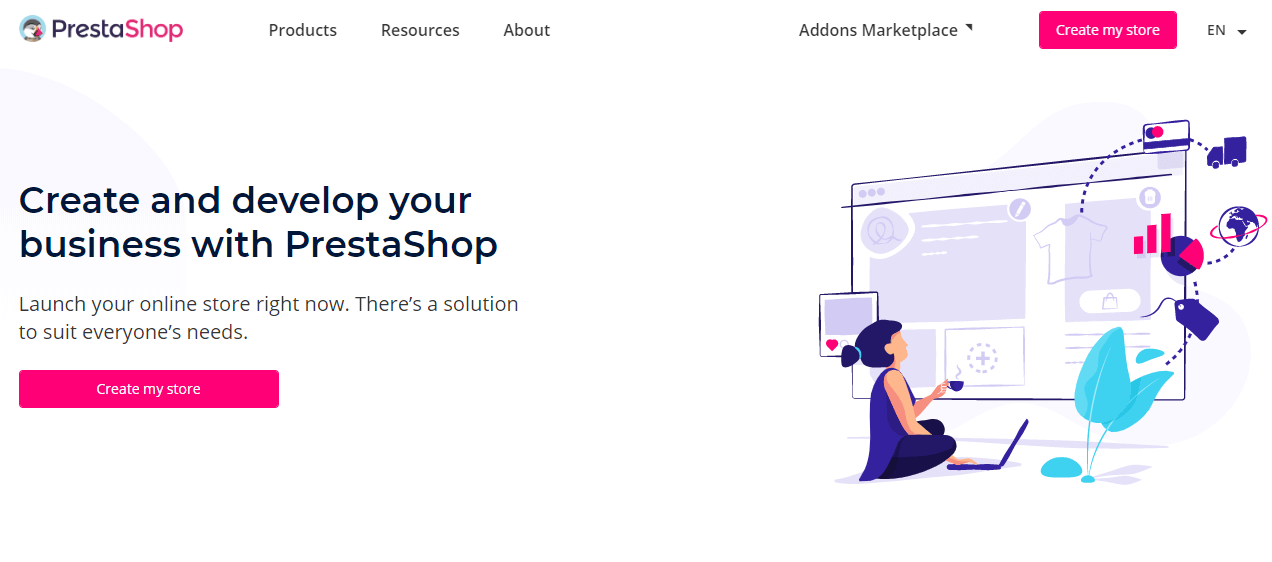
Pricing
PrestaShop is yet another piece of open-source, completely free software. Among similar solutions we’ve reviewed so far, PrestaShop is the most similar to WooCommerce.
Features & functionality
Since PrestaShop is most comparable with WooCommerce, let’s try to understand how it differs from it. We want to pinpoint three key differences.
First, PrestaShop isn’t a plugin (which WooCommerce is) – it’s standalone software.
Due to this, it’s not as easy to set up – you will need to download PrestaShop and install it on your web server manually.
With that in mind, PrestaShop will require some basic technical knowledge, but you will also have a little more flexibility and will have access to all your files.
Secondly, we think that WooCommerce overall is more polished than PrestaShop – it’s way more renowned among online entrepreneurs, and its themes and design features are a little bit more varied.
The third big difference is expansions (called modules in PrestaShop) – here, PrestaShop actually has the edge over WooCommerce.
With over 3,000 modules (WooCommerce has just shy of 500), PrestaShop is way more flexible and can satisfy the needs of various businesses.
The modules can be pretty expensive with PrestaShop though (up to $679.99), so your setup costs may quickly add up with this platform.
However, if you check the available modules out and find that they are exactly what you need, perhaps PrestaShop is a solid alternative to WooCommerce.
Pros:
- Open-source & free.
- All-in-one ecommerce solution.
- Thousands of extensions available.
- All-around solid ecommerce & shopping cart solution – a worthy competitor to WooCommerce.
Cons:
Unlike WooCommerce, needs to be self-hosted.
10. X-Cart
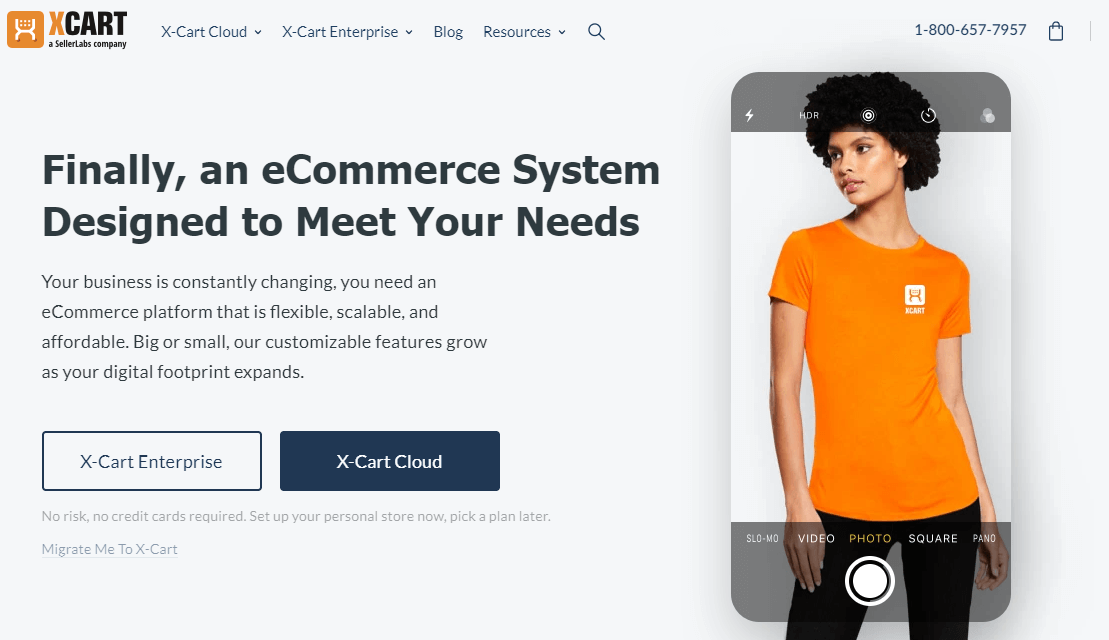
Pricing
X-Cart has the most bizarre pricing scheme among the reviewed shopping carts & ecommerce solutions.
We’ll have to dedicate more to the “pricing” section since our opinion is largely based on precisely X-Cart’s pricing.
Unlike hosted solutions, these versions are intended to be set up on a web server manually.
However, there is also X-Cart Cloud with integrated hosting, so you won’t have to think about setup. Cloud is available for a free trial of 30 days too, which is very nice.
One thing to note with the paid versions (not the Cloud one) is that you are getting free access to updates only for 1 year – then, you will have to pay an annual subscription fee to keep getting upgrades, or you can purchase another year of upgrades for a special low price (in effect for a month after the 1-year license expires):
In contrast, the Free Edition comes with free core upgrades.
What’s interesting about the plans other than Ultimate is that though they lack many features from the top-tier plan, you can actually buy what’s missing as an add-on.
Some add-ons are free, while the paid add-ons’ pricing works just like the plans’ – you pay for the add-on, get free access to upgrades for a year, and then have to buy it again.
Finally, what’s also very unusual is that customer support here is paid – you may buy 24/7 support on an annual or quarterly basis, or you may apply for paid one-time assistance when necessary.
Only the Ultimate plan has support included in the price.
The paid support in X-Cart is strange because paid, subscription-based software typically does include customer support.
For some perspective, in fully free, open-source software, support is usually paid, but that’s not a surprise since the core product itself is free.
The support provided by X-Cart is dedicated though, so it will probably be way better than what you’d be getting with regular support included in paid plans.
With all that in mind, X-Cart surely is NOT for small businesses (unless the Free edition is fine for you) – only established enterprises will be able to even afford it.
Features & functionality
In terms of functionality, X-Cart is one of the best ecommerce & shopping cart solutions out there.
In fact, you are not only getting essential shopping cart features but also excellent scalability, reliability, and mobile performance.
As X-Cart claims, this piece of software easily handles 500k monthly visitors!
Interestingly, X-Cart is also open-source, so if you have a development team, you can just buy it once and shape it to whatever needs you may have – without paying for new versions.
With all that, you get a solution that pretty much has limitless functionality. But it’s very, very expensive – if you want the full set of features, prepare to dig deep into your pockets.
We also don’t really like the fact that features that usually are free in other platforms are behind a paywall here.
Pros:
- All-in-one ecommerce software.
- Has a free version along with several paid plans.
- 30-day free trial for the Cloud version.
- Suitable for large businesses that want scalability, reliability, and top-notch support.
- Dozens of integrations and add-ons.
- 99.9% uptime.
- X-Cart also offers a web hosting service.
Cons:
- Very pricey.
- Rather convoluted pricing scheme.
- Unlike other subscription-based solutions, has support behind a paywall.
11. OpenCart
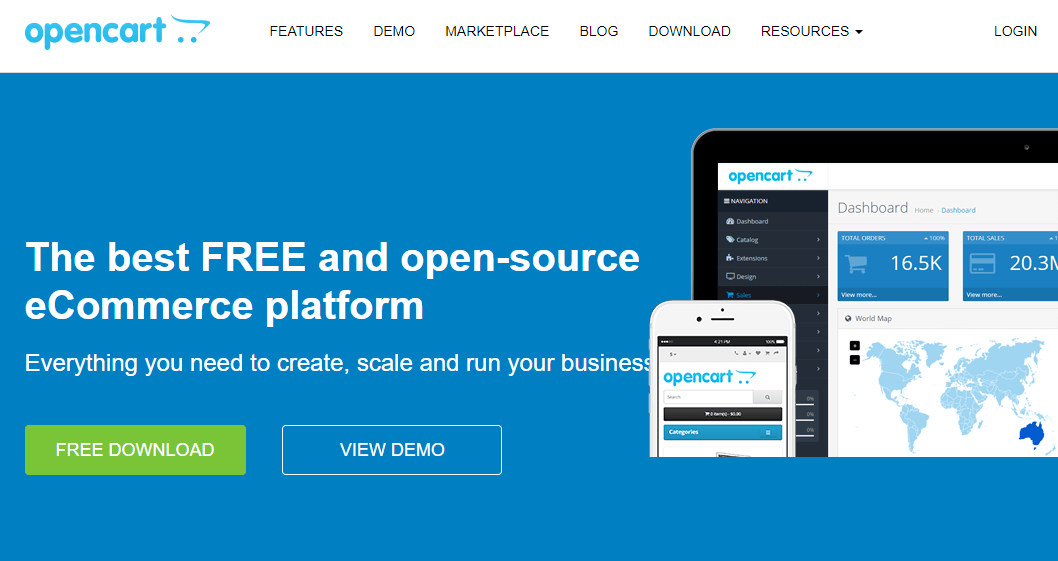
Pricing
OpenCart is very interesting pricing-wise because it provides both free & open-source and hosted solutions. The cloud-hosted software costs as follows:
If bought annually, the plans’ monthly cost is discounted by 50%.
Each of the cloud plans includes customer support, though Silver gets also email support and Gold phone support.
For the self-hosted software, you’ll have to purchase dedicated support ($99 per request or $99 monthly, purchased quarterly).
Features & functionality
For us, the highlight of OpenCart is the built-in affiliate system that allows you to manage your affiliates.
Not that you can’t manage affiliates in the previous open-source shopping cart & ecommerce solutions, but you do need to purchase an add-on for affiliate management. It’s free in OpenCart.
What’s also nice about OpenCart is that it provides unlimited products, categories, as well as over 13 thousand add-ons (both free and paid), which is the most we’ve seen so far.
If previous open-source solutions didn’t seem to provide enough functionality to you, then OpenCart might be a good alternative.
If you want stability, then know that the cloud plans are hosted on Amazon Web Services, so excellent uptime is pretty much guaranteed.
The same goes for scalability, though we wouldn’t say that OpenCart is the best option for huge businesses.
Pros:
- Full ecommerce platform.
- Open-source & free.
- Offers a hosted option with a 14-day free trial.
- Thousands & thousands of add-ons & extensions available.
- Unlimited products and categories.
- Inbuilt affiliate management system.
Cons:
- The non-cloud variant will require manual installation on a web server.
12. PinnacleCart
Pricing
PinnacleCart is available in hosted and self-hosted variants. The hosted software is available in 3 plans:
PinnacleCart also has a 14-day free trial (no credit card necessary) for the Standard and Advanced plans.
The self-hosted solution has individual pricing and includes 1 year of technical support along with 1 year of access to upgrades and new releases.
Additional license purchases after 1 year will come at a 20% discount.
The feature set of the lifetime license is equivalent to Advanced minus the SSL.
All in all, PinnacleCart is rather expensive and definitely isn’t for newbies.
Apart from that, the base Standard plan lacks many of the useful features of the higher-tier plans, so it may not be the best option for some sellers.
Features & functionality
PinnacleCart incorporates not only shopping cart features but also blog-building functionality.
Apart from that, PinnacleCart provides dedicated functionality for mobile and Facebook stores.
Shopping cart-wise, PinnacleCart has traditional features, including real-time shipping with quotes, coupons, discounts, gift cards, cart abandonment remarketing, predictive search, recurring billing, split shipping, order forms, and more.
With that, although PinnacleCart is rather pricey, it provides richer functionality than cheaper solutions.
With the Standard plan, you get most of the must-have things in an online shopping cart.
However, there are some nice perks that Standard doesn’t have – it has no recurring billing, order forms, product features, as well as has limited sales volume, only 3 payment options (more than 30 in the other plans), and limited bandwidth & disc space.
Pros:
- Blog-creating tools & features.
- Both hosted & self-hosted options.
- Unlimited products/categories.
- Nearly the same customer support features in all plans.
- 14-day trial without credit card info.
Cons:
- Rather expensive.
- The low-tier Standard plan has quite limited functionality.
13. UltraCart

Pricing
UltraCart is a hosted ecommerce solution and has the following pricing:
There also is a plan for developers that is completely free and has nearly all features unlocked for testing purposes.
This plan is for those people who are building a web store for their clients.
UltraCart additionally offers a free trial without any credit card information.
Features & functionality
UltraCart is an all-in-one shopping cart & ecommerce solution like many others on our top – apart from online shopping cart essentials, it also has advanced store-building tools along with a few other perks that are worth mentioning.
The first one is the built-in e-mail marketing functionality – although UltraCart is natively integrated with a few pieces of email automation software, it has some features of its own.
UltraCart email is at least worth a try – if it works for you, you won’t have to spend money on a standalone application.
Secondly, another notable feature is the affiliate management platform – not a new thing on our top, but it’s still nice to see in ecommerce software.
Finally, the Small plan is very nice – although it lacks some of the most interesting features of UltraCart (including affiliate management, some integrations, pre-orders, and advanced reports).
It has abandoned cart recovery, recurring billing, shipping rate calculation, upsells, and some other things that lack in the low-tier plans of other solutions.
One thing to note with UltraCart is that it probably isn’t for huge businesses with thousands of customers – even with the Enterprise plan, the integrated email automation service allows for just up to 5k customers and 50k emails for free.
Beyond that, you’ll have to pay a fee based on the number of emails & customers.
Pros:
Allows you to design a web store from zero.
Has affiliate management & email marketing functionality.
All-in-all very feature-rich plans.
Free plan for developers.
Free trial with no credit cards.
Cons:
- Probably not for large businesses with thousands of customers.
- The base plan has relatively limited functionality and misses some important things.
14. nopCommerce
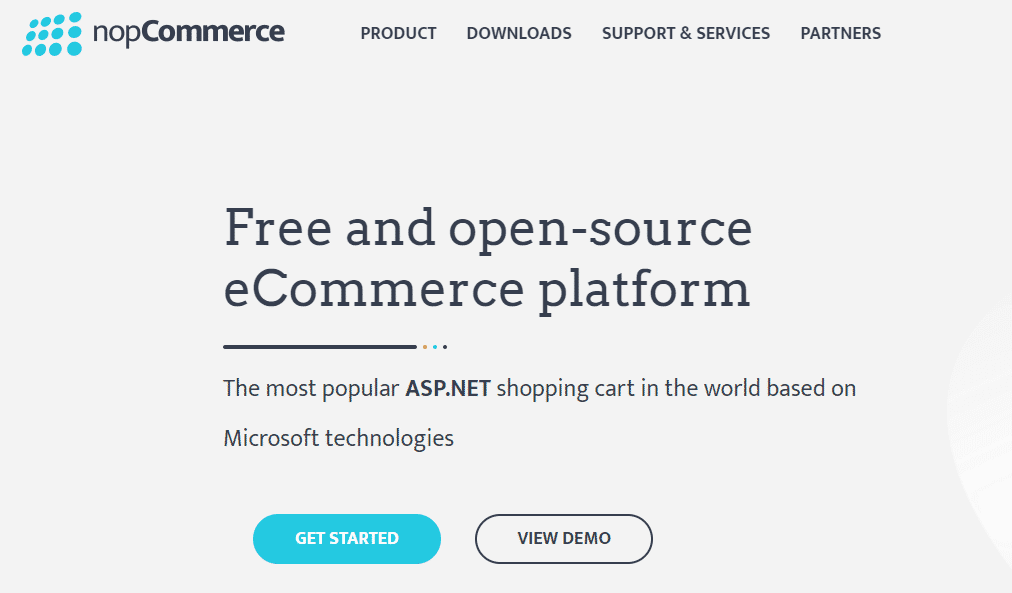
Pricing
nopCommerce is a free and open-source piece of software, but it has paid add-ons and themes.
The add-on pricing is similar to what you can find with WooCommerce and others, but the themes are quite a bit more expensive because they come with paid plugins.
Features & functionality
As an all-in-one ecommerce solution, nopCommerce shares many of its features with its counterparts, including shipping & tax management, payment processing, and web store design.
However, what’s pretty nice about this platform is that it’s easily scalable for large companies (even international ones).
nopCommerce allows you to easily manage multiple stores, with each store having its separate payments, content, tax rules, product prices, and everything else.
Additionally, nopCommerce makes selling with multiple vendors easy, especially with drop shipping.
Upon ordering a product from a vendor, nopCommerce will automatically send an email to that vendor to let them know of the order.
You can easily manage dozens or even hundreds of vendors with nopCommerce too.
nopCommerce also works for small businesses nicely, so you don’t have to be a global company to benefit from this software.
Pros:
- Free and open-source.
- Allows for easy multi-store and multi-vendor management.
- Particularly great for large businesses.
- Expandable via paid and free extensions.
Cons:
- The themes are rather expensive.
- Requires self-hosting.
15. PayKickStart

Pricing
PayKickStart is a hosted piece of software available in 3 plans:
For all the plans, PayKickStart offers a 14-day free trial.
Features & functionality
PayKickStart is a classical shopping cart solution.
It’s not a full ecommerce solution like WooCommerce or Shopify – it’s solely focused on online shopping carts, though it does have some extra features that you may like.
First up, PayKickStart provides you with a visual sales funnel builder tool – a nice thing if you want to min-max your sales process to maximize profit.
Next, PayKickStart has an affiliate management center (starting from the Professional plan) where you can track the performance of your affiliates and pay commissions.
Also, PayKickStart interestingly is more oriented toward digital goods – selling digital products or setting up payments for membership websites is very easy with it.
On the other hand, physical products certainly isn’t a strong suit of PayKickStart – it’s only good for simple physical goods that don’t have lots of variations (color or size, for example).
In terms of functionality, PayKickStart is very nice in all plans – no matter which plan you buy, you’ll get upsells, coupons, 0% transaction fees, tax management, and rich integrations.
Once you go to higher tiers, you’ll get advanced reporting, order bumps, lead tracking, access to API, and more.
Pros:
- Affiliate management center in higher-tier plans.
- Has a visual sales funnel builder.
- Especially suitable for membership sites and digital goods.
- Pretty nice functionality in all plans.
- 14-day free trial.
Cons:
- Limited reporting functionality in low-tier plans.
- Only 5 products in the Basic plan.
- Not the best for selling physical products.
16. Sellfy

Pricing
Sellfy is again a hosted solution and has 3 plans:
Sellfy thus is a little cheaper than PayKickStart if paid monthly and much cheaper if paid annually.
For businesses making over $200k in sales annually, Sellfy offers custom solutions upon getting in touch.
With each of the 3 base plans, you can sign up for a 14-day free trial.
Features & functionality
Sellfy is an online shopping cart plus a web store builder – it has store customization functionality along with mobile optimization.
What we like about Sellfy is that it has unlimited products in all plans, whereas PayKickStart limited its Basic plan to just 5 products.
On the other hand, Sellfy Starter does not have upselling, so there’s that.
Interestingly, Sellfy offers its own email marketing service with Business and Premium plans, with 10k & 50k free credits respectively.
But, of course, you can also pair Sellfy with a third-party email automation service like MailChimp, ConvertKit, AWeber, or MailerLite.
Unlike PayKickStart, Sellfy is a pretty good option for selling physical goods. Managing large inventories of items with multiple variants is pretty easy with this software.
However, note that Sellfy doesn’t provide shipping services, so you’ll have to handle shipping on your own.
Another downside with Sellfy is that it only offers two payment gateways – Stripe and PayPal.
Although Sellfy pays out immediately after you make a sale, due to the payment limitations, this software may not be usable in many countries.
Pros:
- Store customization features.
- Rather inexpensive when purchased annually.
- Unlimited products in all plans.
- Integrated email marketing functionality.
- 14-day free trial available.
- You are paid instantly after every purchase.
Cons:
- Only integrated with Stripe and PayPal for payments.
- Doesn’t provide shipping services.
17. SendOwl
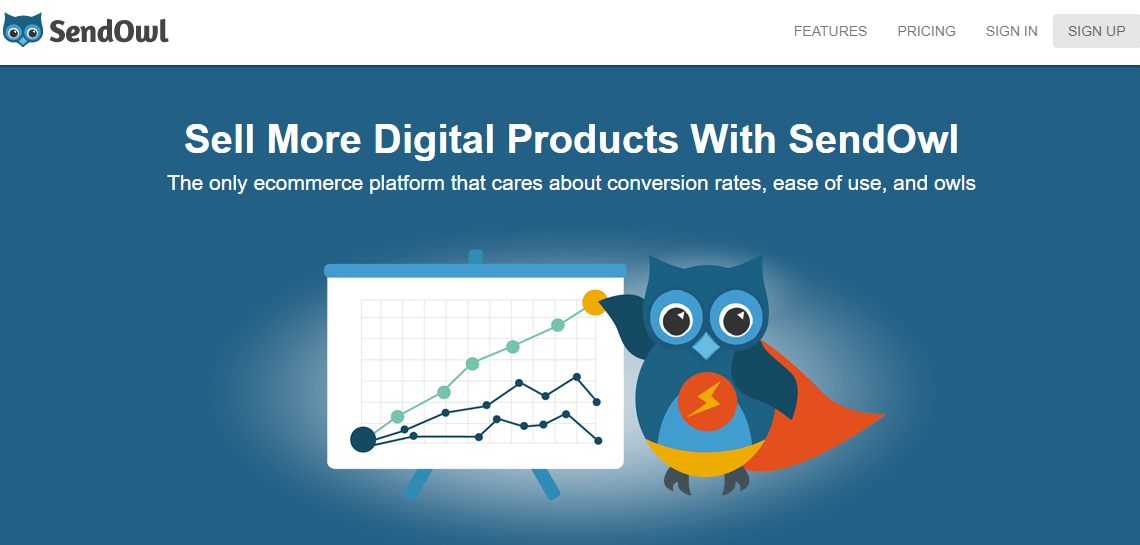
Pricing
SendOwl has a number of software variants for different needs.
First up, we have the Standard (hosted) variant with the following plans:
As you can see, SendOwl is pretty cheap and greatly suitable for small or newly-established businesses.
Next, there is the self-hosted software with these 4 plans:
Finally, there is the Subscription software that is specifically designed for subscription management. It again has 4 plans:
For all these plans, SendOwl offers a 30-day trial with no credit cards.
If you need higher limits than what’s offered by the base plans, you may get in touch with SendOwl for a custom solution.
Features & functionality
SendOwl is specifically designed for selling digital goods – in fact, it perhaps is the most functional solution for digital products out there.
It’s also very cheap, so it’s a good fit or anyone.
SendOwl boasts a few unique things too. For example, it allows you to drip-serve digital content, do quality video streaming, as well as set “pay what you want pricing” for your goods.
SendOwl also provides protection from illegal sharing for PDF products – you can stamp each copy of your e-book or whatnot with the customer’s name, making reselling difficult.
You can additionally manage affiliates with SendOwl, so this platform allows for quite a big growth potential. And overall, SendOwl is great for businesses of any size.
Pros:
- Has affiliate management tools.
- Very cheap.
- Offers a more functional self-hosted option.
- Great for digital products and subscriptions.
- 30-day free trial with no credit cards.
- Supports Bitcoins.
Cons:
- Imposes product limits in all plans.
- Not for physical products.
18. Gumroad
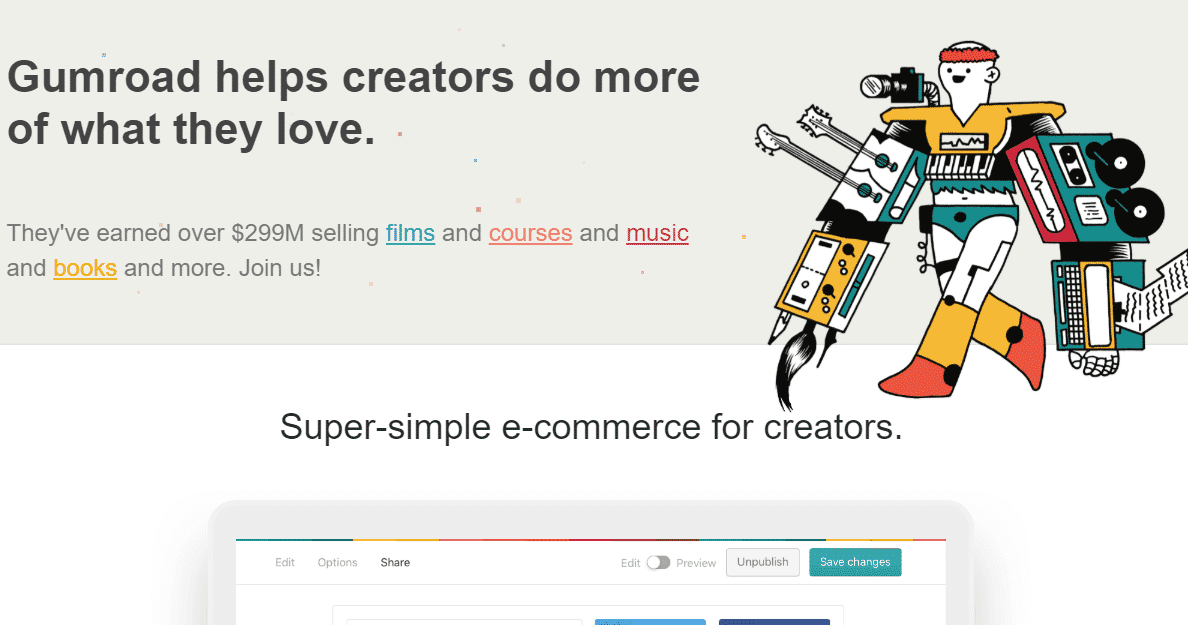
Pricing
Gumroad offers two plans – one is completely free, while the paid Creator plan costs $10 per month.
For each sale, Gumroad charges a transaction fee:
So although Gumroad is very inexpensive, you do have to pay transaction fees.
Features & functionality
The most interesting feature of Gumroad is Discover.
Once you’ve made a sale, your products will be recommended on Gumroad receipts, download pages, and in the Discover section of the Gumroad website.
All this is for a 10% fee off the earnings of the referred products.
Next, Gumroad is more aimed at digital products and creators.
If you look through the existing Discover section, you’ll see plenty of books, comics, apps, courses, and many other digital goods – this is the kind of stuff that Gumroad users already sell.
Gumroad also allows you to protect your works with DRM, generate license keys, sell different versions of the product, as well as allows “pay what you want” pricing.
However, it misses some key things like upsells or bump offers.
All in all, Gumroad is a nice solution if you aren’t doing large-volume selling – in that case, the transaction fees would really add up, and it would make more sense to go for pricier software that has no fees.
Pros:
- Very simple and easy to use piece of ecommerce software.
- Extremely inexpensive.
- Free plan available.
- Aimed at digital products with some physical sales capabilities.
- Gumroad promotes your goods for you for a small fee.
Cons:
- Charges transaction fees unlike most other tools on this list.
- No upsell or bump offer functionality.
- Poor payment gateway selection.
19. Kartra
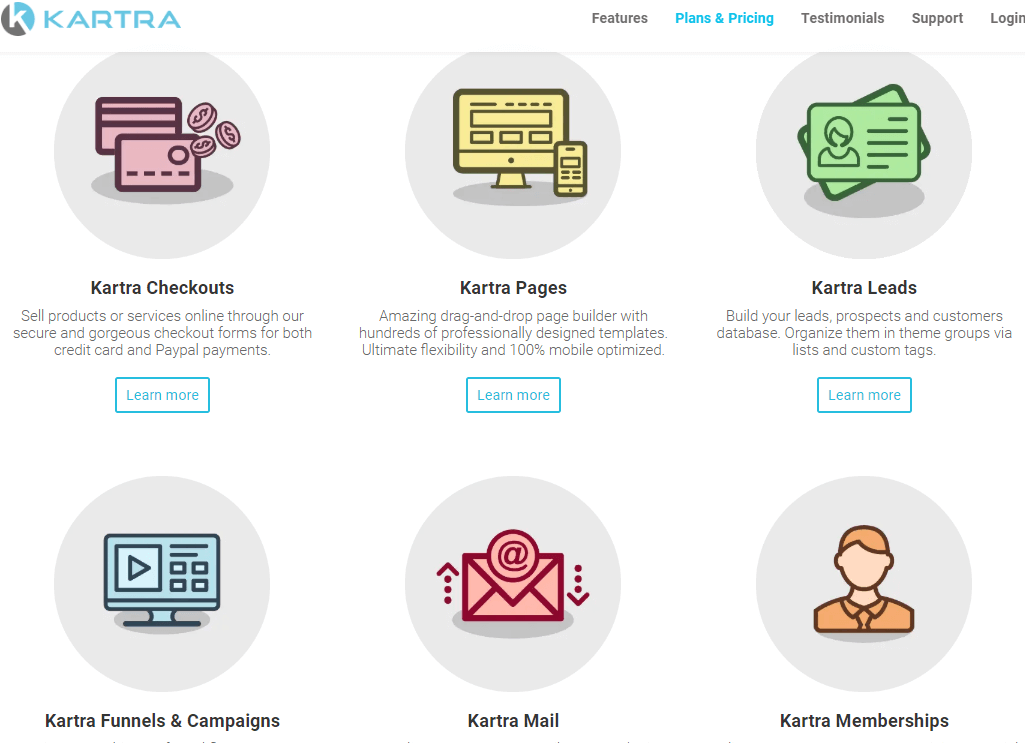
Pricing
Kartra is a rather expensive piece of software. It has 4 plans that cost as follows:
With each plan, you are getting a limited number of domains, but you can purchase add-on domains if necessary.
The Starter plan also has limited emails (15k per month), but that can also be expanded.
Kartra doesn’t offer any free trials – only a 30-day money-back guarantee.
Features & functionality
Kartra is very different from all other solutions on this list – although it does have cart & checkout functionality, it’s much more than that.
It’s an advanced marketing platform that allows you to optimize your sales process, stay in touch with your customers, and manage your affiliates.
Kartra has a strong focus on lead generation and allows you to have up to 50,000 leads in the Platinum plan.
Kartra can divide leads into subgroups and also lets you keep a close eye on how they interact with your store.
With each plan, Kartra additionally provides advanced email automation functionalities, including rule-based automation and split testing.
Thus, sales optimization is very, very easy with Kartra.
Notably, in all plans except for Starter, Kartra also provides unlimited access to many features, including bandwidth, emails, pages, team members, membership sites, and more. So overall, Kartra is a better suit for large, established businesses rather than newbies.
Pros:
- Not just shopping carts – you can create sales funnels, automate emails, and design webpages!
- Great for experienced entrepreneurs.
- Advanced lead generation capabilities.
- Most features are unlimited in higher-tier plans.
- Affiliate management functionality.
Cons:
- Expensive.
- Only 4 payment gateways.
- No free trials – Kartra only provides a 30-day money-back guarantee.
Related : 21 Best ClickFunnels Alternatives
20. Podia

Pricing
Podia has 2 plans:
Although Podia is pricier than Gumroad, Podia doesn’t have any transaction fees. With that, if you will be selling a lot of digital goods, Podia is a better choice.
Features & functionality
Podia has pretty much everything you’d need to grow a successful business – email marketing tools, affiliate management, fully customizable sales pages, funnels, and many other things.
With Podia, you are unlikely to have to purchase any third-party tool.
It’s a full-blooded ecommerce solution for not too much money.
Like Gumroad, Podia is focused on digital products. Although Podia doesn’t offer the neat Discover feature, you are getting much wider functionality, including but not limited to upsells.
However, it has very few payment gateways – only 2, to be exact, which is PayPal & Stripe. This will severely limit the country availability of this tool, though PayPal works in most countries around the world.
Overall, we’d say that Podia is way better software for those whose business is primarily focused on sales of digital products.
Gumroad would probably be a better solution for side income.
Pros:
- All-in-one tool with email marketing, affiliate management, page builder, etc.
- Excellent for high-volume selling of digital goods.
- 14-day free trial with no credit card information.
- Zero transaction fees (unlike Gumroad).
Cons:
- Pricey.
- Only Stripe & PayPal supported as payment gateways.
21.Quick eSelling

Pricing:
Quick eSelling offers 4 plans
- Free: $0 per month (5% transaction fee)
- Standard: $199 per month (zero transaction fee)
- Pro: $399 per month (zero transaction fee)
- Premium: $599 per month (zero transaction fee)
The free plan is good for small scale businesses and individuals who want to test the water before they invest in lots of development.
Features & Functionality:
Quick eSelling is a fully managed and hosted ecommerce platform that comes with a single CRM to manage website and app.
It is a one-stop ecommerce store builder for grocery, fashion, electronics, and many other industries.
The platform is integrated with leading payment gateways such as CCAvenue, Authroize.net, PayUmoney, etc.
Also, to make tax management & business processes simpler, the platform is integrated with ERP like QuickBooks and SAP.
Ease of use is another area where the Quick eSelling platform stands out.
The platform comes with features like advanced order management, bulk import/export, discount coupon management, intuitive checkout, etc.
Quick eSelling Pros:
- Start an online store for free in only 10 mins
- Fully managed and hosted ecommerce platform
- Customizable front-end
- Integration with popular APIs
Quick eSelling Cons:
- Limited themes
- Paid plans are expensive
22. Yo!Kart
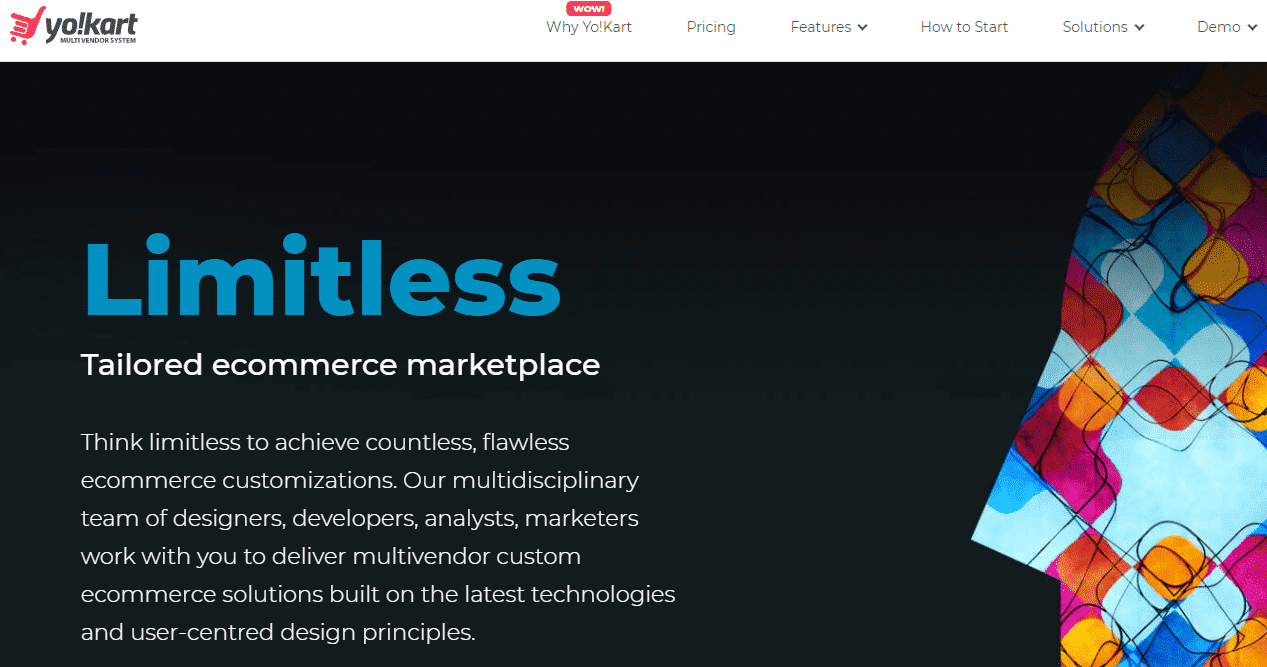
Pricing:
- GoQuick: $999
- GoCustom Lite: $3999
- GoCustom: $5999
All pricing packages come with a lifetime license, full source code, 1-year free tech support, and free installation. Also, Yo!Kart offers one special hosted solution package for startups that’s available at $500 for 1-year.
Features & Functionalities:
Yo!Kart is a multi-vendor eCommerce platform that has been used by 1000+ businesses across the globe.
The platform is fully customizable and scalable, thus allows businesses to grow at their own pace.
To build a high-end online marketplace, Yo!Kart has all the key and standard eCommerce features such as
- Separate vendor storefronts
- Multi-cart checkout
- Multilingual and Multi-Currency
- Product catalog module
- Ready apps for buyers and sellers
- Multiple payment options
- Advanced order management
- Marketing features like Abandoned cart and discount coupons management
- Intuitive Admin & Seller panels
Also, Yo!Kart is pre-integrated with popular APIs such as Quickbooks, Stripe Connect, ShipStation, TaxJar, etc.
The user-interface of the platform is unbeatable among all the existing multi-vendor ecommerce platforms.
Yo!Kart team is constantly evolving its platform to meet the needs of today's and future customers.
Pros:
- Inherently Multi-vendor platform
- Comes with key features and functionalities
- Lifetime license (No recurring charges)
- 100% customizable
- 1-year free technical support
Cons:
- Upgrades are paid
- Themes are costly
23. Selldone.com
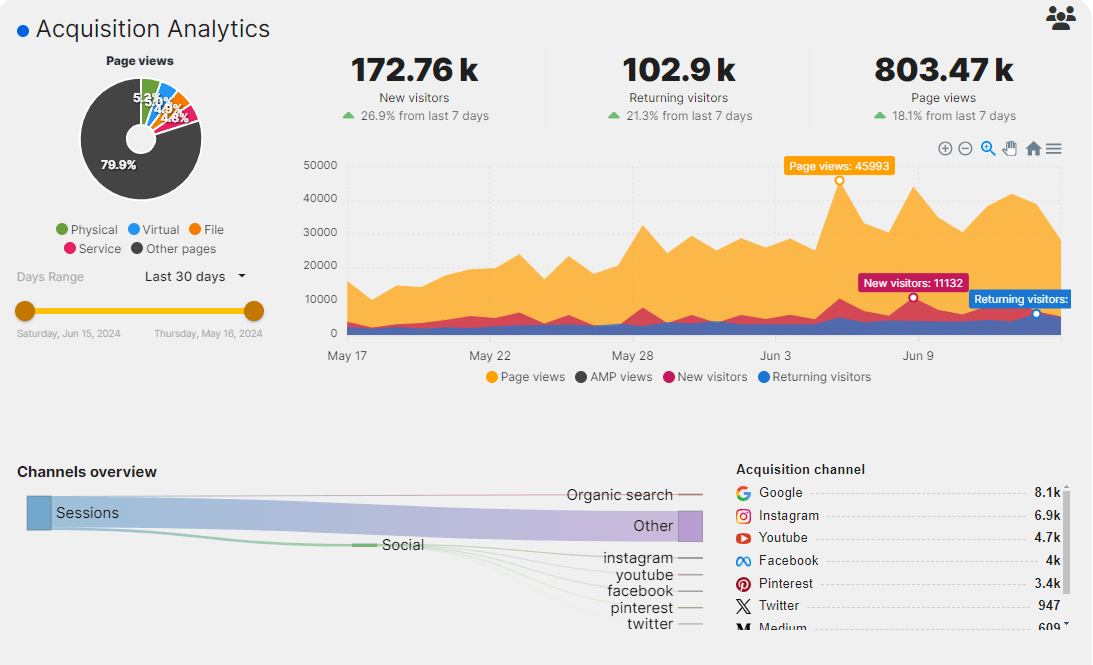
Selldone isn't your average cookie-cutter ecommerce platform. It positions itself as a robust yet user-friendly business operating system (OS) designed specifically for ecom ventures. Whether you're a seasoned seller or a complete ecommerce newbie, Selldone promises a smooth ride from store setup to scaling your online empire.
Key Features to Streamline Your Sales:
- All-in-One Powerhouse: Inventory management, product listings, order processing, marketing tools - Selldone integrates everything you need under one roof. No more juggling multiple platforms and logins.
- Drag-and-Drop Design Freedom: Unleash your inner designer! Selldone boasts a user-friendly interface that lets you customize your online store's look and feel without needing to write a single line of code.
- Dropshipping Friendly: Thinking of launching a dropshipping business? Selldone seamlessly integrates with popular dropshipping suppliers, saving you time and resources.
- Marketplace Potential: Looking to expand beyond your own product line? Selldone allows you to create a marketplace, transforming your store into a multi-vendor hub.
Pros:
- Intuitive Interface: Even non-tech-savvy users can navigate Selldone with ease.
- Scalability: The platform can grow alongside your business, accommodating an increasing product range and customer base.
- Comprehensive Feature Set: Selldone eliminates the need for multiple subscriptions by offering a wide range of built-in tools.
Cons:
- Learning Curve: While user-friendly, Selldone's extensive feature set might have a slight learning curve for complete beginners.
- Limited App Integrations: While Selldone offers a good selection of built-in tools, the app marketplace might be less extensive compared to some competitors.
Selldone Pricing
Selldone offers three pricing tiers catering to different business needs. Pricing is clear and displayed upfront on their website. They also provide a free 14-day trial, allowing you to test-drive the platform before committing.
The Free Plan Advantage:
Selldone stands out with its generous free plan, aptly named "Free." It's ideal for entrepreneurs dipping their toes into the ecommerce world. This plan provides everything you need to launch your online store, including:
- Unlimited products
- 1GB storage
- Unlimited bandwidth
- All professional features and tools
- Drag-and-drop landing page builder
This eliminates the initial financial hurdle, allowing you to test the platform's functionality and build your online presence before committing to a paid plan. Selldone even takes care of software updates and security, so you can focus on building your brand and making sales, not technical headaches.
Paid Plans for Growth:
In addition to the free plan, Selldone offers three paid subscriptions: Startup, Company, and Enterprise. These plans progressively unlock additional features and resources as your business grows. Here's a quick breakdown:
- Startup ($9.99/month): Ideal for small businesses starting out, it includes all free plan features with increased storage, SMS login for customers, and the ability to integrate 3D/AR functionalities.
- Company ($69.00/month): Perfect for established small and medium businesses, it offers everything in the Startup plan, plus unlimited storage, priority support, the ability to manage multiple domains, and the option to have up to 20 admins.
- Enterprise ($299.00/month): Designed for large-scale businesses, it unlocks all Company plan features with unlimited domains, unlimited admins, an advanced community builder tool, and integration with dropshipping suppliers.
What Is The Purpose Of An Online Shopping Cart?
Now, let’s try to understand how a shopping cart can help both buyers and sellers.
There is a lot to cover here, so let’s talk about shopping cart benefits for buyers and sellers separately.
How an online shopping cart helps buyers?
First up, buyers – here’s what an online shopping cart can do for them:
- Accumulate goods: Before checkout, a shopping cart allows your customers to review the desired products and make adjustments as they see fit – maybe add some things or remove others.
What’s also nice about online shopping carts is that they allow customers to gather a few products and come back to them later – maybe after some good thinking or when they have time.
- Calculate costs. Shopping cart software can calculate the costs of purchase, including not only the price of the product but also packaging, labeling, and shipping.
- Calculate taxes. If applicable, shopping carts can also calculate taxes associated with the chosen goods.
When it comes to costs, perhaps the nicest thing of shopping carts for buyers is that they automatically calculate the order total.
So a shopping cart can also be used as a budgeting tool of sorts, as well as allows people to avoid launching their smartphones’ calculators.
How an online shopping cart helps sellers?
What about sellers?
Well, the usefulness of an online shopping cart is actually much, much bigger for sellers than for buyers.
For customers, a shopping cart is just a convenient tool that allows them to gather a few products, see if their price is right, and then proceed to payment.
As for sellers, shopping carts allow them to make business decisions or even increase sales.
To make things a little clearer to you, let’s cover a few things that an online shopping cart would allow you to do.
Believe it or not, but whether someone will actually buy from you hugely depends on customer experience, particularly in the shopping cart.
No matter how good your prices are, no matter how great your product selection is, if the purchasing process is inconvenient and shady, then you are very likely to lose a buyer.
As mentioned above, an online shopping cart allows you to take care of basic customer needs and make the shopping a little more convenient.
But more importantly, cart software provides you with improved control over the user experience, including:
- What information is required from the buyer for a purchase.
- How payments are handled.
- What information is provided to the buyer.
- How your shopping cart looks visually.
These are small yet very important factors in your success – make sure that you build a simple to use cart system to minimize the chance of cart abandonment.
Secondly, online shopping carts allow you to handle payments easily.
Shopping carts often support popular payment gateways (credit cards or PayPal, for example) by default, making integration with them easy.
Some software may also have integrated payment gateways, allowing you to avoid pairing two pieces of software (shopping cart & payment gateway) together.
If not for this support of payment gateways, you would have to handle payments manually – a technically tedious process, especially in terms of safety.
And just like an online shopping cart allows you to avoid writing code for the cart’s functionality, payment integration allows you to avoid manual payment processing.
As a result, a shopping cart makes payments easy and safe both for sellers and buyers.
Next, a shopping cart allows you to gather customer data. And this is a huge benefit for you.
Thanks to the data provided by a shopping cart, you can actually track and analyze the behavior of your buyers.
For some perspective, here’s what the collected data may help you determine:
- What time of day or what day of the week your customers are most active on.
- What kind of products your customers are interested in.
- Why your customers abandon their shopping carts.
- Which stages of the buying process your customers linger on the most.
What kind of data you will be able to gather exactly depends on your software.
Some online shopping carts provide you with plenty of stats & reports by default, while others may require some customization or won’t provide good info at all.
This is why it’s very important that you pay careful attention to the reporting & stat-collecting capabilities before buying cart software.
Anyway, as you could have guessed, this kind of data allows you to identify bottlenecks in your sales funnel and hopefully resolve them.
Not only that, but if you have a product recommender algorithm implemented, you might observe better conversion rates because your store will guide buyers where they want to be.
Now, of course, there are some data-related issues that arise from the use of such information – you’ll have to let your buyers know what you collect and what for, and you’ll also need to make sure that all the data is secure.
These are just small details though – what’s way more important for you is that you can gather very useful insight into customer behavior, make their experience more convenient, and your profits higher.
How you will do it, that’s another story – you may opt for AI-powered algorithms, for example, but that has some other challenges that are well beyond the scope of this post.
Offer upsells, downsells, or complementary products
And the last benefit & purpose of an online shopping cart we want to cover is that you can offer complementary offers, upsells, or downsells right as your visitors are shopping for something.
For example, if your customer is shopping for a game console, you may offer a few videogame options for it.
Or maybe an additional controller, or a gaming headset. These are examples of complementary products (also called order bumps).
Another example – if your customer is looking for a vacuum cleaner, you might offer them a few more expensive options in the shopping cart to hopefully make a bigger sale. This would be an upsell.
Or, if you determine that your customer adds something to their cart but doesn’t make a purchase for some time, you may offer them a downsell – a cheaper product that they might buy more readily because it’s more pocket-friendly.
Now, not every shopping cart will support complementary products, upsells, or downsells, but if yours does, then know that you’ll have access to a goldmine that will open up plenty of new money-making opportunities to you.
Shopping Cart VS Ecommerce Platform

Another important thing to talk about is the difference between a shopping cart solution and ecommerce software.
If you are considering buying a shopping cart application, then you are probably also considering buying an ecommerce solution.
Well, which one do you need to buy? Maybe both? Let’s try to give answers to these questions below.
What’s ecommerce software?
So we know what an online shopping cart is, but what is ecommerce software?
Ecommerce software is a solution that allows you to set up an entire online store from scratch, including your product catalog, product descriptions, and shopping cart functionality.
With an ecommerce solution, you can also manage your inventory, add or remove products, create the layout for your product pages, and do anything else necessary to build an online store.
As an all-in-one solution, ecommerce platforms incorporate all the tools & functionality necessary to create a store, including a shopping cart. An online shopping cart is thus just a component of ecommerce software.What to choose – an online shopping cart or ecommerce software?
Based on the above, here is what you may be wondering about – if ecommerce software can do everything (including shopping carts), why would you even want to purchase a shopping cart separately?
Well, here are some cases when you would want to opt for a standalone shopping cart solution:
- You already have a website and just want to add shopping functionality to it. If you think that the only thing that your website misses is a shopping cart, then there is no need for you to purchase ecommerce software.
- You don’t need the advanced customization features of ecommerce software. Read through the feature list of the ecommerce solution that interests you – if it offers more than you need, why bother?
- Besides, if you have a simple store with maybe 2-3 products, then you should be able to easily manage your offerings without ecommerce software.
- If selling online isn’t the main monetization method of your website. If you only want to sell a few products or services for some side income, then there is no need for ecommerce software – you should be able to manage everything easily without any advanced tools.
- Your current ecommerce solution doesn’t have the shopping cart functionality you want. This one’s simple – if your current ecommerce platform provides a subpar shopping cart, you may either purchase a separate shopping cart solution or switch to a different piece of ecommerce software altogether.
And here’s when you would want to purchase full-fledged ecommerce software:
- Your main focus is sales. In this case, an ecommerce solution would probably be worth the money.
- You have dozens or even hundreds of products to sell. Ecommerce software would make inventory management much, much easier if you have many products.
- You want full control over your catalog. Typically, shopping carts don’t allow for flexible management of a product or service catalog. If you want to customize your online store to deliver the best user experience, then ecommerce software is the way to go.
You may have to do a lot of research to determine whether you need a shopping cart solution or ecommerce software.
But no matter what, your choice will ultimately come down to what you need right now and what available options allow.
Try to understand what you want – this should make the decision process easier.
Try to use as few pieces of software as possible
To close off this section, a pro tip – try to use as few pieces of software as you can.
If possible, buy only an ecommerce solution or a shopping cart (Like Shopify) – if you get both, you may have to deal with the headache of software integration.
Ecommerce software typically has some native integrations with third-party shopping carts, so you should come across few to no problems when pairing them.
However, incompatibilities are still possible, especially if the software gets updated frequently.
Another reason to buy only one solution is that you will have to manage only one database.
Unless your software allows you to import your own databases, you will be forced to use whatever database storage solution each software provider uses.
Managing one database is a big challenge enough – managing two is double the headache.Finally, you will just save money with one piece of software.
Of course, if you need both shopping cart and ecommerce solutions, they may be worth it – but if possible, try to minimize your expenditures and just pick a single solution that you will do the job the best.Tips & Strategies For Using Shopping Cart Software
To deliver an optimal shopping experience and hopefully maximize your sales, here are a few tips & strategies to follow when using shopping cart solutions.
1. Let customers know of all costs BEFORE they go the cart
First and foremost, do let your visitors know of ALL COSTS before they get to the cart.
These costs include shipping, taxes, or whatever other costs may be incurred in addition to the price of the product.
This is very important because unexpected costs that show up only in the shopping cart are among the top reasons for shopping cart abandonment, As many as 86% of shopping carts are abandoned, according to statistics, so it's essential to avoid it.
Display all the shipping or tax cost information right on the product page. If your shipping costs aren’t fixed, embed a shipping fee calculator as well.
2. Make sure that the shopping cart is visible
Many people use shopping carts as a wish list of sorts – they may fill their carts with items and come back to them weeks or months later.
Well, once people do come back, they should be reminded that they have items in their shopping carts.
The shopping cart icon should be clearly visible on the webpage and catch the visitor’s attention.
Days or weeks after filling their carts, people won’t necessarily buy anything, but it’s better to take the chance by reminding people of unpurchased products.
3. Provide detailed product summaries
Include key product information in your shopping cart, including:
- A bright, clear, and sufficiently big product image.
- Product name.
- Key specs (if applicable).
- The number of added products.
- Color & size.
Display the order total detailing all costs as well. This will help people quickly review their cart before purchasing.
4. Allow guest checkouts
Don’t force people to sign up on your store to purchase goods – this is annoying and very likely to repulse many people.
Internet users have a lot of accounts on various websites and platforms these days, and adding one more to that already huge list is a big thing to ask.
5. Allow visitors to save their carts
This one somewhat ties back to the previous point.
Since people often use shopping carts as wish lists, you should allow your visitors (most importantly, those who don’t have an account on your website) to save their shopping cart to access it later from any other device.
Some shopping cart solutions may have such functionality built-in, but you may use third-party plugins as well.
6. Make the checkout fast & easy
Ensure that the checkout process is simple and fast.
Don’t force people through 10 webpages, and minimize the amount of information that needs to be entered to make a purchase.
Optimize your website as well to make sure that there are no annoying performance hiccups.
A good idea would also be to include a “Remember Me” checkbox at checkout, which would allow buyers to save the entered information and avoid entering it again the next time they buy from you.
After payment, offer people to sign up as well again to simplify their future purchasing process.
7. Showcase security badges & trust seals
Strongly consider investing in security badges as well (like
Technical security is, of course, important, but visually reinforcing it will have a much larger impact on users who aren’t aware of the means you’ve used to secure their payments.
8. Offer various payment options
Not everybody realizes this, but payment option variety is crucial to making a sale.
This is especially true if you are selling internationally or aren’t based in the US – in some areas, the availability of payment services like PayPal may be limited.
Here are payment gateways you could and should use on your store:
- Credit or debit cards.
- PayPal.
- Stripe.
- Apple Pay.
- Google Pay.
- Amazon Pay.
- Authorize.Net.
Integrate as many secure gateways as you can – this will allow people to avoid having to sign up for new payment services, as well as will ensure that people in other countries have payment options.
9. Show complementary products in the shopping cart
Finally, try showing complementary products in the shopping cart.
Repeating our example from earlier, if a visitor has a game console in their cart, then show a compatible videogame, headset, or gamepad.
Don’t forget about upsells & downsells as well (if applicable).
If you don’t have many products on your website, then you may link items together manually so that they show up as complementary for each other.
But if there are many products on your website, you will have to resort to recommendation algorithms.
Summary
Hopefully, after reading our post, you know exactly which shopping cart solution would be perfect for you!
In our opinion, SamCart & ThriveCart stand out the most – the former is excellent for medium to large businesses who want advanced cart features, while the latter is an amazing all-in-one solution for a good price (remember, it’s a limited offer).
Remember to check the features of the desired shopping cart application and ideally purchase a solution that provides exactly what you need – no more and no less.
Confirm that you don’t need ecommerce software instead as well. I would recommend here Shopify especially if you do dropshipping.
Discuss available options with your team too – they might provide you with more useful insight into the challenges and benefits of each available solution.
Further readings :

